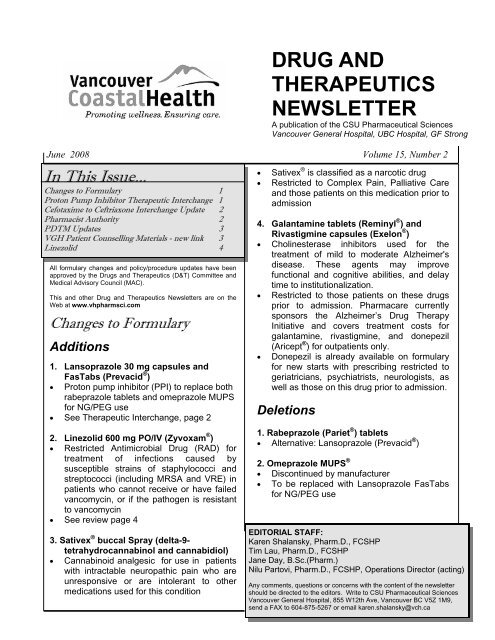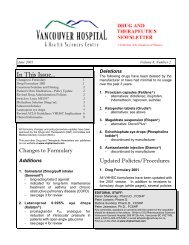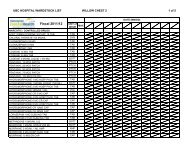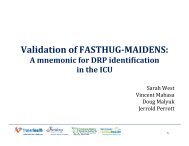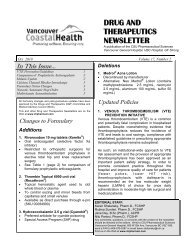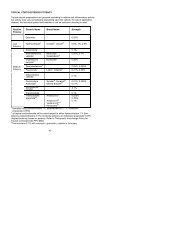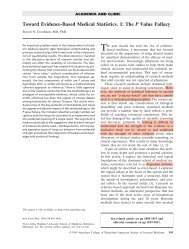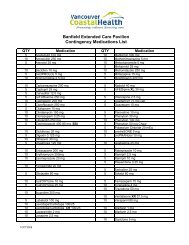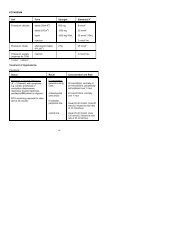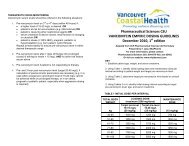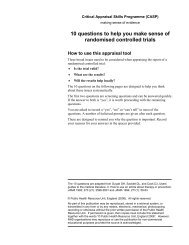Drug and Therapeutics Newsletter - Pharmaceutical Sciences
Drug and Therapeutics Newsletter - Pharmaceutical Sciences
Drug and Therapeutics Newsletter - Pharmaceutical Sciences
You also want an ePaper? Increase the reach of your titles
YUMPU automatically turns print PDFs into web optimized ePapers that Google loves.
June 2008 Volume 15, Number 2<br />
In This Issue...<br />
Changes to Formulary 1<br />
Proton Pump Inhibitor Therapeutic Interchange 1<br />
Cefotaxime to Ceftriaxone Interchange Update 2<br />
Pharmacist Authority 2<br />
PDTM Updates 3<br />
VGH Patient Counselling Materials - new link 3<br />
Linezolid 4<br />
All formulary changes <strong>and</strong> policy/procedure updates have been<br />
approved by the <strong>Drug</strong>s <strong>and</strong> <strong>Therapeutics</strong> (D&T) Committee <strong>and</strong><br />
Medical Advisory Council (MAC).<br />
This <strong>and</strong> other <strong>Drug</strong> <strong>and</strong> <strong>Therapeutics</strong> <strong>Newsletter</strong>s are on the<br />
Web at www.vhpharmsci.com<br />
Changes to Formulary<br />
Additions<br />
1. Lansoprazole 30 mg capsules <strong>and</strong><br />
FasTabs (Prevacid ® )<br />
• Proton pump inhibitor (PPI) to replace both<br />
rabeprazole tablets <strong>and</strong> omeprazole MUPS<br />
for NG/PEG use<br />
• See Therapeutic Interchange, page 2<br />
2. Linezolid 600 mg PO/IV (Zyvoxam ® )<br />
• Restricted Antimicrobial <strong>Drug</strong> (RAD) for<br />
treatment of infections caused by<br />
susceptible strains of staphylococci <strong>and</strong><br />
streptococci (including MRSA <strong>and</strong> VRE) in<br />
patients who cannot receive or have failed<br />
vancomycin, or if the pathogen is resistant<br />
to vancomycin<br />
• See review page 4<br />
3. Sativex ® buccal Spray (delta-9-<br />
tetrahydrocannabinol <strong>and</strong> cannabidiol)<br />
• Cannabinoid analgesic for use in patients<br />
with intractable neuropathic pain who are<br />
unresponsive or are intolerant to other<br />
medications used for this condition<br />
DRUG AND<br />
THERAPEUTICS<br />
NEWSLETTER<br />
A publication of the CSU <strong>Pharmaceutical</strong> <strong>Sciences</strong><br />
Vancouver General Hospital, UBC Hospital, GF Strong<br />
• Sativex ® is classified as a narcotic drug<br />
• Restricted to Complex Pain, Palliative Care<br />
<strong>and</strong> those patients on this medication prior to<br />
admission<br />
4. Galantamine tablets (Reminyl ® ) <strong>and</strong><br />
Rivastigmine capsules (Exelon ® )<br />
• Cholinesterase inhibitors used for the<br />
treatment of mild to moderate Alzheimer's<br />
disease. These agents may improve<br />
functional <strong>and</strong> cognitive abilities, <strong>and</strong> delay<br />
time to institutionalization.<br />
• Restricted to those patients on these drugs<br />
prior to admission. Pharmacare currently<br />
sponsors the Alzheimer’s <strong>Drug</strong> Therapy<br />
Initiative <strong>and</strong> covers treatment costs for<br />
galantamine, rivastigmine, <strong>and</strong> donepezil<br />
(Aricept ® ) for outpatients only.<br />
• Donepezil is already available on formulary<br />
for new starts with prescribing restricted to<br />
geriatricians, psychiatrists, neurologists, as<br />
well as those on this drug prior to admission.<br />
Deletions<br />
1. Rabeprazole (Pariet ® ) tablets<br />
• Alternative: Lansoprazole (Prevacid ® )<br />
2. Omeprazole MUPS ®<br />
• Discontinued by manufacturer<br />
• To be replaced with Lansoprazole FasTabs<br />
for NG/PEG use<br />
EDITORIAL STAFF:<br />
Karen Shalansky, Pharm.D., FCSHP<br />
Tim Lau, Pharm.D., FCSHP<br />
Jane Day, B.Sc.(Pharm.)<br />
Nilu Partovi, Pharm.D., FCSHP, Operations Director (acting)<br />
Any comments, questions or concerns with the content of the newsletter<br />
should be directed to the editors. Write to CSU <strong>Pharmaceutical</strong> <strong>Sciences</strong><br />
Vancouver General Hospital, 855 W12th Ave, Vancouver BC V5Z 1M9,<br />
send a FAX to 604-875-5267 or email karen.shalansky@vch.ca
<strong>Drug</strong> <strong>and</strong> <strong>Therapeutics</strong> <strong>Newsletter</strong> 2 Volume 15, Number 2<br />
3. Diethylsilbestrol injection (Honvol ® ),<br />
Stilbestrol tablets<br />
• Discontinued by manufacturer<br />
4. Edrophonium injection (Enlon ® )<br />
• Discontinued by manufacturer<br />
Updated Policies/Procedures<br />
1. THERAPEUTIC INTERCHANGE: PROTON<br />
PUMP INHIBITORS (PPI)<br />
Effective Jun 1, 2008, all PPIs ordered for oral or<br />
NG/PEG use will be automatically interchanged to<br />
lansoprazole 30 mg capsules or 30 mg FasTabs,<br />
respectively.<br />
2. THERAPEUTIC INTERCHANGE UPDATE:<br />
CEFOTAXIME TO CEFTRIAXONE<br />
A therapeutic interchange protocol was<br />
implemented in Sept 2007 to auto-substitute<br />
cefotaxime to genericized ceftriaxone. Recent<br />
revised labeling of ceftriaxone recommends<br />
avoiding the co-administration of this drug with IV<br />
solutions containing calcium following reports of 8<br />
deaths in children up to 1 year of age who received<br />
this combination. This recommendation extends to<br />
both adults <strong>and</strong> children, even though there is no<br />
indication that a similar risk exists in adults. As a<br />
result, on June 16, 2008 the following revisions to<br />
the ceftriaxone interchange will be implemented:<br />
• All patients on TPN will be excluded from this<br />
interchange; thus all patients on TPN will remain<br />
on cefotaxime as ordered<br />
• For all ceftriaxone orders, pharmacy will screen<br />
patients for calcium containing TPN orders <strong>and</strong><br />
contact the prescriber to switch to cefotaxime<br />
• All ceftriaxone labels will have the notation “do not<br />
give concurrently with IV calcium”. This comment<br />
will also appear on the MAR for ceftriaxone.<br />
3. PHARMACIST AUTHORITY<br />
As part of the regional VCH pharmacist prescribing<br />
authority approved in March 2008, the following<br />
pharmacist authorities will be implemented on June<br />
16, 2008 at Vancouver Acute (VA)<br />
Unit-based clinical pharmacists can independently<br />
write orders for multivitamins (PO/enteral), Nicotine<br />
Replacement Therapy (NRT), Calcium/Vitamin D,<br />
dosage adjustment of anti-infective drugs based on<br />
renal function, <strong>and</strong> any laboratory test associated<br />
with monitoring of drug therapy without prior<br />
physician consultation. The following conditions<br />
must apply:<br />
A. Multivitamins<br />
Unit-based clinical pharmacists may order all<br />
formulary multiple vitamin preparations for<br />
ORAL <strong>and</strong> ENTERAL administration (as long<br />
as the patient is able to take medications via<br />
naso-gastric tube <strong>and</strong> is not NPO) at the usual<br />
recommended daily dose without a physician's<br />
order. Single entity vitamin <strong>and</strong> parenteral<br />
preparations must still be ordered by a<br />
physician.<br />
i) Multivitamin supplements will be considered<br />
only if program patient care guidelines<br />
recommend a multivitamin supplement for<br />
patient’s condition, or if all the following criteria<br />
are met:<br />
• Patient is malnourished or at risk of nutritional<br />
deficiencies<br />
• Expected length of stay is greater than 7 days<br />
• Patient is unable to eat sufficient food/<br />
supplements to meet daily recommended intake<br />
(DRI)<br />
• Patient is unable to modify dietary intake to<br />
meet DRI<br />
• If iron supplementation is problematic based on<br />
a patient’s co-existing condition (e.g.<br />
hemosiderosis, iron overload syndrome), then<br />
iron-containing multivitamin products (i.e.<br />
Centrum Forte ® /Select ® ) should not be ordered<br />
without prior consultation with a physician.<br />
ii) The pharmacist consults with the patient <strong>and</strong><br />
the patient is agreeable to initiate therapy.<br />
iii) The pharmacist communicates the order by<br />
writing a note in the history section of the<br />
chart to indicate the rationale for multivitamin<br />
therapy. A copy of this note is given to the<br />
resource pharmacist for the purpose of quality<br />
assurance.<br />
B. Nicotine Replacement Therapy (NRT)<br />
Unit-based clinical pharmacists may write an<br />
order for NRT using the pre-printed NRT<br />
order form (PPO #638) as long as:<br />
i) NRT has been reviewed with the patient <strong>and</strong><br />
there are no contraindications to use (refer to<br />
PPO). The risks/benefits to initiate NRT have<br />
been explained to the patient <strong>and</strong> the patient<br />
is willing to start therapy.<br />
ii) NRT patient teaching sheet(s) are given to<br />
<strong>and</strong> discussed with patient.<br />
iii) The pharmacist communicates the order by<br />
writing a note in the history section of the<br />
chart to indicate the rationale for NRT <strong>and</strong><br />
follow-up plan. A copy of this note is given to<br />
the resource pharmacist for the purpose of<br />
quality assurance.
<strong>Drug</strong> <strong>and</strong> <strong>Therapeutics</strong> <strong>Newsletter</strong> 3 Volume 15, Number 2<br />
iv) The patient is monitored for desired therapeutic<br />
outcome.<br />
C. Calcium <strong>and</strong>/or Vitamin D therapy<br />
Unit-based clinical pharmacists may write orders<br />
for calcium <strong>and</strong>/or vitamin D therapy for the<br />
treatment or prevention of osteoporosis/bone<br />
disease as long as:<br />
i) The patient was taking these preparations prior to<br />
admission; OR<br />
ii) The dosage <strong>and</strong>/or formulation that was<br />
prescribed are different from what the patient<br />
was taking prior to admission <strong>and</strong> it is clear that<br />
this formulation <strong>and</strong>/or dosage is what the<br />
patient should be taking (e.g. calcium carbonate<br />
500 mg (Tums) vs calcium carbonate 1250 mg<br />
(ApoCal = 500 mg elemental calcium).<br />
iii) The pharmacist reviews the patient medications<br />
<strong>and</strong> disease states to rule out any<br />
contraindications (e.g. known hypercalcemia,<br />
end-stage renal disease).<br />
iv) The pharmacist consults with the patient <strong>and</strong> the<br />
patient is agreeable to continue with therapy.<br />
v) The pharmacist communicates the order by<br />
writing a note in the history section of the chart<br />
indicating the rationale for this therapy. A copy<br />
of this note is given to the resource pharmacist<br />
for the purpose of quality assurance.<br />
vi) The patient is monitored for potential side<br />
effects.<br />
D. Modify Dosage of Anti-Infective <strong>Drug</strong>s based<br />
on Renal Function<br />
Unit-based clinical pharmacists may change the<br />
dose <strong>and</strong>/or frequency of oral or parenteral antiinfective<br />
drugs based on renal function to improve<br />
the safety <strong>and</strong>/or effectiveness of a regimen<br />
according to the following conditions:<br />
i) The prescribed dose <strong>and</strong>/or frequency of the<br />
anti-infective agent is not appropriate for the<br />
patient’s level of renal function.<br />
ii) The pharmacist has access to appropriate<br />
clinical information to make the regimen<br />
change.<br />
iii) The pharmacist ensures the modified dose is<br />
adequate for the indication.<br />
iv) If the patient is being followed by the Infectious<br />
Diseases (ID) team, the pharmacist should liaise<br />
with the ID pharmacist prior to any dosage<br />
adjustments.<br />
v) Recommendations are based on those listed in<br />
the VA PDTM or formulary.<br />
vi) The pharmacist communicates this change by<br />
writing a note in the history section of the chart<br />
to indicate the rationale for the change <strong>and</strong> the<br />
follow-up plan. A copy of this note is given to<br />
the resource pharmacist for the purpose of<br />
quality assurance.<br />
vii) The pharmacist continues to manage <strong>and</strong><br />
monitor the drug regimen. It is the<br />
responsibility of the pharmacist taking care<br />
of the patient to ensure there is a transfer of<br />
care before leaving the service.<br />
viii) The pharmacist ensures appropriate<br />
laboratory tests are ordered for on-going<br />
monitoring (i.e. serum creatinine, BUN, drug<br />
levels).<br />
E. Order Serum <strong>Drug</strong> Levels <strong>and</strong> other<br />
Laboratory Tests Associated with <strong>Drug</strong><br />
Therapy Monitoring<br />
Unit-based clinical pharmacists may order<br />
serum concentrations of all measurable drug<br />
levels including (but not limited to)<br />
aminoglycosides (with serum creatinine),<br />
carbamazepine, cyclosporine, digoxin, lithium,<br />
phenobarbital, phenytoin (with serum<br />
albumin), tacrolimus, theophylline, valproic<br />
acid, <strong>and</strong> vancomycin (with serum creatinine).<br />
Unit-based clinical pharmacists may order any<br />
laboratory test to guide in drug therapy<br />
decision making.<br />
4. PDTM UPDATES<br />
Updated policies include:<br />
• Fentanyl subcutaneous infusions: both<br />
Palliative Care <strong>and</strong> Complex Pain Services<br />
may order SC fentanyl infusions for patients<br />
where IV access is an issue.<br />
• Sodium bicarbonate infusions used for<br />
prevention of radiographic contrast dyemediated<br />
nephropathy: it is no longer<br />
necessary to withdraw 150 mL from the 1 L<br />
D5W bag prior to the addition of 150 mL<br />
sodium bicarbonate (total volume = 1150 mL).<br />
• Medications administered via subcutaneous<br />
infusion are ideally run at flow rates of 1-10<br />
mL/hour in minimal volume; flow rates should<br />
not exceed 25 mL/hour.<br />
5. PATIENT TEACHING SHEETS - NEW<br />
INTRANET LINK<br />
The VGH patient teaching sheets are now<br />
located on the VCH Connect homepage. Click on<br />
the “Clinical” tab <strong>and</strong> then “VGH Patient<br />
Counselling Materials”.
<strong>Drug</strong> <strong>and</strong> <strong>Therapeutics</strong> <strong>Newsletter</strong> 4 Volume 15, Number 2<br />
Linezolid (Zyvoxam ® )<br />
Tim T.Y. Lau, Pharm.D., Karen Shalansky, Pharm.D.<br />
Pharmacology<br />
Linezolid is a synthetic antibacterial agent of a new<br />
class, the oxazolidinones. It exhibits activity against<br />
Gram-positive pathogens, such as Staphylococcus,<br />
Streptococcus, <strong>and</strong> Enterococcus (including<br />
methicillin-resistant Staphylococcus aureus (MRSA)<br />
<strong>and</strong> vancomycin-resistant Enterococcus (VRE)).<br />
The mechanism of action of linezolid differs from<br />
other antibacterial agents. It binds to the 23S<br />
ribosomal bacterial RNA, <strong>and</strong> effectively inhibits<br />
protein synthesis. Due to this unique mechanism of<br />
action, cross-resistance to other classes of antibiotics<br />
is unlikely.<br />
Linezolid is completely absorbed after oral dosing<br />
with an absolute bioavailability of 100%, which is not<br />
affected by the administration of food. Peak plasma<br />
levels are achieved within 1-2 hours. The oral route<br />
is preferred unless GI compromise is suspected.<br />
Linezolid is primarily metabolized by the liver (65%);<br />
dosage adjustments are not required in renal failure<br />
<strong>and</strong> mild-moderate hepatic dysfunction. Doses<br />
should be given post-hemodialysis, as approximately<br />
30% of a dose is removed via dialysis.<br />
Adverse Effects <strong>and</strong> <strong>Drug</strong> Interactions<br />
Most common side effects include headache,<br />
diarrhea, <strong>and</strong> nausea/vomiting (Table 1).<br />
Myelosuppression (thrombocytopenia, neutropenia,<br />
anemia, <strong>and</strong> pancytopenia) may occur with use<br />
beyond 2 weeks. It is recommended to monitor CBC<br />
weekly if anticipated therapy is greater than 2 weeks,<br />
especially in patients with pre-existing bleeding,<br />
Table 1. Comparison of Linezolid, Daptomycin, <strong>and</strong> Tigecycline<br />
thrombocytopenia, myelosuppression or those<br />
who are on concomitant drugs that may suppress<br />
the bone marrow.<br />
Linezolid is a weak MAO-A <strong>and</strong> MAO-B inhibitor.<br />
Patients should be monitored for excessive high<br />
blood pressure if receiving an interacting drug,<br />
such as adrenergic agents (e.g. epinephrine,<br />
pseudoephedrine), serotonergic agents (e.g.<br />
citalopram, fluoxetine, fluvoxamine, nefazodone,<br />
sertraline, venlafaxine), meperidine,<br />
dextromethorphan, <strong>and</strong> foods with high tyramine<br />
content (e.g. aged cheese, beer, red wine).<br />
Comparison to Other Agents<br />
Vancomycin is the treatment of choice for<br />
hospital-acquired MRSA. Daptomycin <strong>and</strong><br />
tigecycline are 2 non-formulary agents available<br />
in Canada that have activity against both MRSA<br />
<strong>and</strong> VRE (Table 1). Daptomycin is the only<br />
agent that has bactericidal activity against VRE.<br />
Indications for Use at VA <strong>and</strong> Dosage<br />
Linezolid is a Restricted Antimicrobial <strong>Drug</strong><br />
(RAD) at VA limited to the treatment of infections<br />
caused by susceptible strains of staphylcocci <strong>and</strong><br />
streptococci (including MRSA <strong>and</strong> VRE) in<br />
patients who 1) cannot receive vancomycin due<br />
to hypersensitivity or intolerance; 2) have failed<br />
to respond to vancomycin; or 3) have a pathogen<br />
resistant to vancomycin.<br />
The dosage is 600 mg PO/IV twice daily for 10-<br />
28 days depending on the infection. Special<br />
Authority is required as an out-patient for<br />
Pharmacare coverage unless prescribed by an<br />
Infectious Diseases Specialist.<br />
<strong>Drug</strong> Linezolid (Zyvoxam ® ) Daptomycin (Cubicin ® )** Tigecycline (Tygacil ® )**<br />
Class Oxazolidinone Lipopeptide Glycylcycline (tetracycline-derivative)<br />
Activity<br />
MSSA, MRSA,<br />
Streptococcus/<br />
Enterococcus/VRE<br />
MSSA, MRSA,<br />
Streptococcus/Enterococcus/<br />
VRE<br />
MSSA, MRSA, Streptococcus/<br />
Enterococcus/VRE, Enterobactericiae,<br />
Bacteroides<br />
Dosage 600 mg PO/IV BID 4 to 6 mg/kg IV daily 100 mg IV x 1, then 50 mg IV Q12H<br />
Renal Failure No dose adjustments; give<br />
dose post-hemodialysis<br />
Adverse<br />
Effects<br />
<strong>Drug</strong><br />
Interactions<br />
Headache, diarrhea,<br />
nausea, thrombocytopenia,<br />
neutropenia<br />
Weak MOA-A <strong>and</strong> MAO-B<br />
inhibitor - see text<br />
< 30 mL/min = Q48H dosing No dose adjustments<br />
Headache, insomnia,<br />
hypotension, nausea, renal<br />
failure, phlebitis, rash,<br />
anemia, abnormal LFTs, CPK<br />
Caution with concomitant<br />
statins <strong>and</strong> aminoglycosides<br />
Cost*/day $191 (IV); $141 (PO) $138 (70 kg patient) $165<br />
*based on wholesaler costs; **non-formulary at VA<br />
Nausea (20%), vomiting (13%),<br />
abdominal pain, photosensitivity, acute<br />
pancreatitis, anaphylaxis/<br />
anaphylactoid reactions<br />
May decrease clearance of warfarin;<br />
monitor INR


